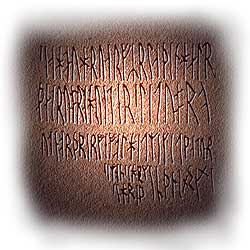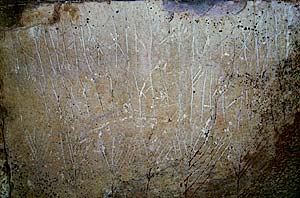
 |
 |
| Home |
| About Orkney |
| History |
| Tradition |
| Folklore |
| Placenames |
| Images |
| Downloads |
| About the Site |
| Contact |
| Links |
| Search Site |
| Awards |
| Runes in Orkney | |
|
"Here is a work for poets;
Carve the runes
This forced them to make do with simple drawings that could be easily scratched on stone or wood. Over time these rough scratches developed into more complex writing forms. An example of this development is the runic alphabets used by the Germanic peoples of western Europe. Here, the scratched symbols developed into the angular lettering known as runes. Although there is evidence that an early form of runic writing was in existence as early as the second century AD, it is not known exactly where and when the runes we recognise today were first introduced. Runes are formed from angular, straight lines, a shape dictated by the material used for recording the messages – usually wood, bone or stone. The message had to be cut quickly with a blade or axehead - a method that was not conducive to overly-complicated designs. Magical purposes Not surprisingly given their mythological origin (see side panel), the runes were first and foremost seen as having a magical and ritual function. They were used for divination as well as other "magical" purposes, such as controlling the weather, the tides and crops and other facets of daily life. Magical runes were carved on amulets, drinking cups, spears and ships to provide protection for the owner, or simply to enhance the power of the object. Over time, however, although the magical power of the runes was still respected, they began to be used more as a simple method of communication. By the end of the Viking period they were no longer the property of soothsayers and sorcerers but were commonly used by ordinary people.
Now runes were used to leave messages as well as mark property and belongings. When the Norsemen first began arriving in Orkney in the 8th century, they brought with them the art of rune-carving. Runic finds in Orkney A few sites across the islands have yielded evidence of runes, the most famous and extensive of which is the collection in the Stenness chambered cairn Maeshowe.
Here, one of the largest collections of runic inscriptions in Europe is on view to the public. Aside from the Maeshowe runes, there are 19 documented examples of runes found in Orkney - as well as a few whose authenticity are open to question. For example, when the Orphir Round Kirk was demolished in 1757, a rune-inscribed stone was discovered, apparently from the fabric of the building. The translated runes read: "the church is not good". Other runic inscriptions can still be seen in the stalled cairn of Unstan and carved on one of the standing stones within the Ring of Brodgar. |
The word "rune" derives from the Old Norse word meaning "secret writing". In German it is related to the word "secret" or "whisper" Aside from the runic collection found in Maeshowe, there have been 19 examples of runes found in Orkney - as well as a few whose authenticity are open to question. According to Norse mythology, the god Odin, in an effort to learn the secrets of life and death, sacrificed himself by hanging upside-down from the world-ash tree Yggdrasil, impaled by his own spear. For nine days and nine nights he hung, gazing down into the depths of Niflheim. During this ordeal, and tormented by pain, hunger and thirst, Odin won the knowledge he sought. When he had fully mastered this knowledge, he cut magical runes on his spear, Gungnir, upon the teeth of his horse, Sleipnir among other things. |
||||||||||||||||||||||||||||||||||||||||||


